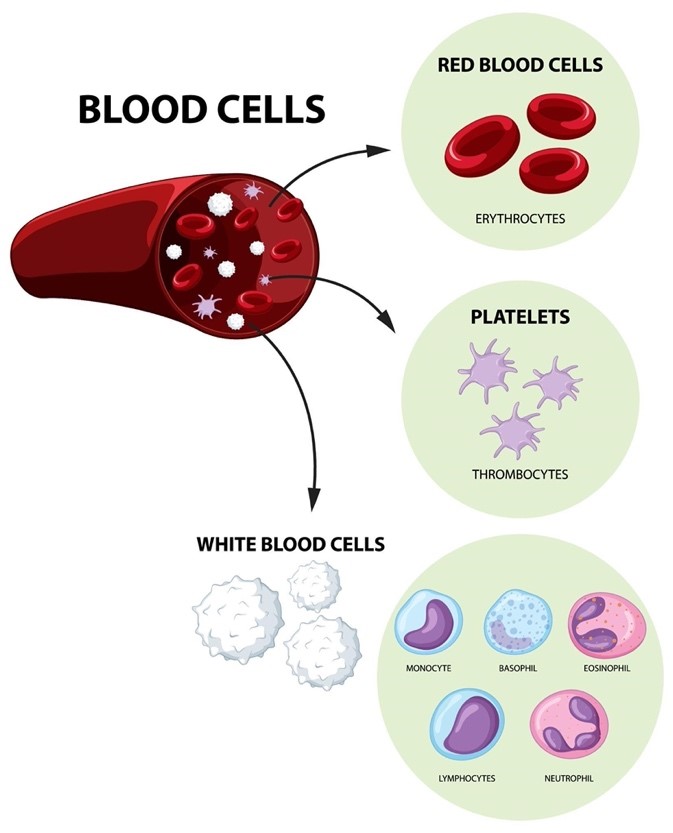Description

Source: MedKart
Disclaimer: Copyright infringement not intended.
Context
- Platelet transfusions are vital in managing severe bleeding, surgical procedures, and chemotherapy. However, challenges such as limited supply, short shelf life, and compatibility issues persist.
- Researchers at North Carolina State University and the University of North Carolina at Chapel Hill have developed synthetic platelets to address these challenges, aiming to enhance hemostasis and tissue healing.
Details
About Synthetic Platelets
- Synthetic platelets are hydrogel nanoparticles mimicking human platelets in size, shape, and mechanical properties, offering versatility in clinical use.
- Engineered with antibody fragments targeting fibrin, synthetic platelets facilitate clot formation and contraction, expediting the healing process.
About Platelets
- Platelets, also known as thrombocytes, are small, disc-shaped blood cells essential for hemostasis—the process of preventing and stopping bleeding.
- Despite their size, platelets play crucial roles in various physiological processes beyond hemostasis, making them indispensable components of the circulatory system.
Structure and Composition:
- Cellular Structure: Platelets lack a nucleus and are derived from precursor cells in the bone marrow called megakaryocytes.
- Cytoplasmic Components: Their cytoplasm contains granules filled with bioactive molecules such as clotting factors, growth factors, and cytokines.
- Surface Receptors: Platelets are equipped with surface receptors that allow them to interact with other blood cells, vessel walls, and various signaling molecules.
Hemostatic Functions:
- Primary Hemostasis: Platelets adhere to damaged blood vessel walls, aggregate, and form temporary plugs to seal small breaches in the vessel wall.
- Secondary Hemostasis: They participate in the coagulation cascade, where clotting factors are activated to form a stable fibrin clot, reinforcing the platelet plug.
Beyond Hemostasis:
- Inflammation: Platelets release inflammatory mediators and cytokines, modulating the immune response and promoting tissue repair.
- Angiogenesis: They secrete growth factors that stimulate the formation of new blood vessels, crucial for wound healing and tissue regeneration.
- Tissue Repair: Platelets contribute to tissue regeneration by releasing factors that stimulate cell proliferation and differentiation.
Platelet Disorders:
- Thrombocytopenia: Characterized by abnormally low platelet counts, leading to an increased risk of bleeding.
- Thrombocytosis: Occurs when platelet counts are abnormally high, potentially leading to thrombotic events such as strokes or heart attacks.
- Platelet Dysfunction: Impaired platelet function can result from various genetic disorders, medications, or underlying medical conditions, leading to abnormal bleeding or clotting.
Clinical Applications:
- Blood Transfusions: Platelet transfusions are used to treat thrombocytopenia and prevent bleeding in patients undergoing chemotherapy or surgery.
- Antiplatelet Therapy: Medications such as aspirin and clopidogrel inhibit platelet function, reducing the risk of arterial thrombosis and cardiovascular events.
- Platelet-Rich Plasma (PRP) Therapy: Utilized in regenerative medicine, PRP contains a high concentration of platelets and growth factors, promoting tissue repair and regeneration in various medical conditions.

Conclusion
- Synthetic platelets represent a promising innovation in hemostasis management, offering an accessible and efficient alternative to conventional platelet transfusions.
- With continued research and regulatory approvals, synthetic platelets have the potential to revolutionize bleeding control and tissue healing, benefiting patients in diverse clinical scenarios.
Sources:
MedicalXpress
|
PRACTICE QUESTION
Q. Discuss the potential impact of synthetic platelets on medical treatment and healthcare systems. (150 Words)
|















